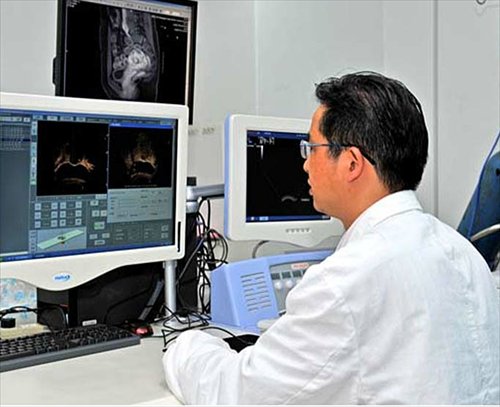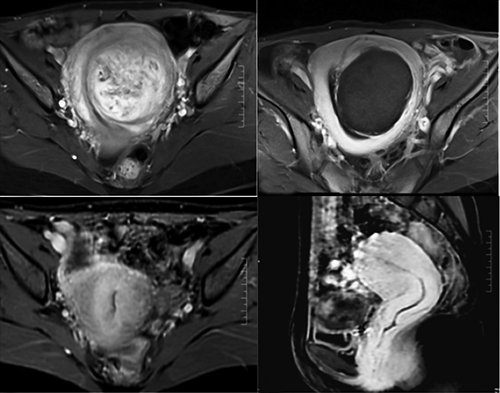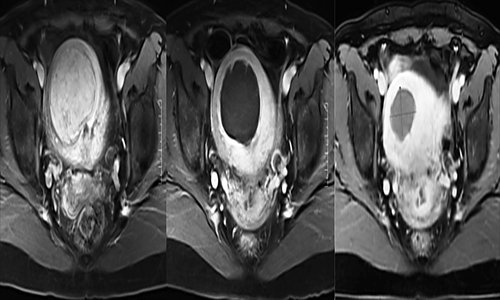HOME >> METRO SHANGHAI
Noninvasive alternatives
By Du Qiongfang Source:Global Times Published: 2015-12-20 19:13:01
Up to 80 percent of women across the world develop uterine fibroids, a type of noncancerous tumor that can grow on the uterine wall, during their middle and late reproductive years. In 2014 alone, an estimated 200 million women worldwide were affected by fibroids, which often have no symptoms but can severely affect a woman's pregnancy.
Numerous medical reports cite African American women as the most susceptible ethnic group to develop uterine fibroids, also called hysteromyoma. But in the past decade Chinese women, currently at 30 percent nationwide, have seen an increasingly high prevalence of uterine tumors due to greater lifestyle pressures, decreased physical exercise and a cultural shift toward unhealthy diets.
However, rather than seek immediate medical treatment, costly medical procedures and a collective societal fear toward invasive surgeries are the leading reasons why many Chinese women choose to just ignore benign fibroids rather than have them removed.
Another factor that previously dissuaded Chinese women diagnosed with fibroids from having surgery was the former one-child policy. As the average female in China will have one child before the age of 30 - the general age that the tumors start to appear - heretofore most women had little reason to be concerned about the potential negative effects uterine fibroids could have on a second pregnancy.
But after State planners scrapped China's one-child law earlier this year, a rising number of women over the age of 30 are now seeking medical consultations and physical examinations to explore the idea of having a second child. As such, hysteromyoma interventional procedures are becoming more frequent.
High-intensity ultrasound
Traditionally, Chinese hospitals will suggest invasive operations such as laparoscopic or open surgery, which require incisions into the belly followed by two years of rehabilitation before pregnancy. Even in Shanghai, known for its cutting-edge healthcare facilities, most top-tier hospitals will try to push costly abdominal surgeries on prospective patients.
Nonetheless, following this reporter's own recent experience seeking out less-invasive hysteromyoma treatment alternatives (see "Shanghai doctors corrupted by greed and negligence," December 9, 2015), painful, bloody scenes atop an operating table no longer need be part of having one's uterine fibroids removed.
Some Shanghai gynecologists have been endeavoring to inform local women of new advances in noninvasive surgical options with less scarring, bleeding and pain that can be performed on an outpatient basis. Among these advancements, high-intensity focused ultrasound (HIFU) ablation has become the toast of the town for local women seeking uterine fibroids treatments involving minimal pain, low complications and quick recovery times. A HIFU ablation procedure costs 14,000 yuan ($2,159).
"More than 500 patients have received HIFU ablation procedures to cure uterine fibroids or adenomyosis at our hospital," said Xu Yonghua, chair of the Department of Imaging and Interventional Therapy at Xuhui District Central Hospital. "From their postoperative recovery conditions, the recurrence rate of these patients is lower than patients who receive traditional operations."
Ms Ye, 41 years old, from Germany, who underwent an HIFU procedure in Shanghai, found out during her half-year follow-up that her uterine fibroid had successfully shrunk from 71mm to 36mm.
HIFU treatments employ high intensity, focused ultrasound pulses to destroy diseased tissue on the uterine wall. During the procedure, ultrasound beams reaching up to 60 - 70 C are focused on the fibroids, achieving a precise ablation (necrosis) of the tissue. Because the ultrasound energy passing through outer tissue has no apparent physical effect, that is considered "noninvasive."
Prior to the three-hour operation, patients receive only painkiller medication and are kept conscious so as to be able to communicate with the doctor. During the ultrasound sonication, one will feel heat and a slight pain according to the stage, size and position of the tumor. If patients feel too much pain, the doctor can adjust the heat levels.
In order to assure their safety during the treatment, patients are restricted to a semi-liquid diet for at least one day prior to the operation. They must also drink a strong purgative to completely empty their stomach and receive a bowel-cleansing enema before the ultrasound sonication procedure.
Perhaps the biggest upside for working women undergoing an HIFU treatment is the quick recovery stage - just one to two days for postoperative observation - which allows women to immediately return to work. Women wishing to get pregnant as soon as possible can conceive a mere two months after their treatment, as opposed to the two years required for patients who received a laparoscopic surgery. This is a blessing for women of advanced reproductive age who urgently want a second child but have fibroids.
It is important to note that around 90 percent of women with uterine fibroids qualify for HIFU treatment, and some of the patients who undergo HIFU will require additional treatments at some point later in order to fully remove the diseased tissue. But the numerous and rapid technological advancements being made in ablation procedures means that expensive and painful open surgeries are no longer the only option for women.



Numerous medical reports cite African American women as the most susceptible ethnic group to develop uterine fibroids, also called hysteromyoma. But in the past decade Chinese women, currently at 30 percent nationwide, have seen an increasingly high prevalence of uterine tumors due to greater lifestyle pressures, decreased physical exercise and a cultural shift toward unhealthy diets.
However, rather than seek immediate medical treatment, costly medical procedures and a collective societal fear toward invasive surgeries are the leading reasons why many Chinese women choose to just ignore benign fibroids rather than have them removed.
Another factor that previously dissuaded Chinese women diagnosed with fibroids from having surgery was the former one-child policy. As the average female in China will have one child before the age of 30 - the general age that the tumors start to appear - heretofore most women had little reason to be concerned about the potential negative effects uterine fibroids could have on a second pregnancy.
But after State planners scrapped China's one-child law earlier this year, a rising number of women over the age of 30 are now seeking medical consultations and physical examinations to explore the idea of having a second child. As such, hysteromyoma interventional procedures are becoming more frequent.
High-intensity ultrasound
Traditionally, Chinese hospitals will suggest invasive operations such as laparoscopic or open surgery, which require incisions into the belly followed by two years of rehabilitation before pregnancy. Even in Shanghai, known for its cutting-edge healthcare facilities, most top-tier hospitals will try to push costly abdominal surgeries on prospective patients.
Nonetheless, following this reporter's own recent experience seeking out less-invasive hysteromyoma treatment alternatives (see "Shanghai doctors corrupted by greed and negligence," December 9, 2015), painful, bloody scenes atop an operating table no longer need be part of having one's uterine fibroids removed.
Some Shanghai gynecologists have been endeavoring to inform local women of new advances in noninvasive surgical options with less scarring, bleeding and pain that can be performed on an outpatient basis. Among these advancements, high-intensity focused ultrasound (HIFU) ablation has become the toast of the town for local women seeking uterine fibroids treatments involving minimal pain, low complications and quick recovery times. A HIFU ablation procedure costs 14,000 yuan ($2,159).
"More than 500 patients have received HIFU ablation procedures to cure uterine fibroids or adenomyosis at our hospital," said Xu Yonghua, chair of the Department of Imaging and Interventional Therapy at Xuhui District Central Hospital. "From their postoperative recovery conditions, the recurrence rate of these patients is lower than patients who receive traditional operations."
Ms Ye, 41 years old, from Germany, who underwent an HIFU procedure in Shanghai, found out during her half-year follow-up that her uterine fibroid had successfully shrunk from 71mm to 36mm.
HIFU treatments employ high intensity, focused ultrasound pulses to destroy diseased tissue on the uterine wall. During the procedure, ultrasound beams reaching up to 60 - 70 C are focused on the fibroids, achieving a precise ablation (necrosis) of the tissue. Because the ultrasound energy passing through outer tissue has no apparent physical effect, that is considered "noninvasive."
Prior to the three-hour operation, patients receive only painkiller medication and are kept conscious so as to be able to communicate with the doctor. During the ultrasound sonication, one will feel heat and a slight pain according to the stage, size and position of the tumor. If patients feel too much pain, the doctor can adjust the heat levels.
In order to assure their safety during the treatment, patients are restricted to a semi-liquid diet for at least one day prior to the operation. They must also drink a strong purgative to completely empty their stomach and receive a bowel-cleansing enema before the ultrasound sonication procedure.
Perhaps the biggest upside for working women undergoing an HIFU treatment is the quick recovery stage - just one to two days for postoperative observation - which allows women to immediately return to work. Women wishing to get pregnant as soon as possible can conceive a mere two months after their treatment, as opposed to the two years required for patients who received a laparoscopic surgery. This is a blessing for women of advanced reproductive age who urgently want a second child but have fibroids.
It is important to note that around 90 percent of women with uterine fibroids qualify for HIFU treatment, and some of the patients who undergo HIFU will require additional treatments at some point later in order to fully remove the diseased tissue. But the numerous and rapid technological advancements being made in ablation procedures means that expensive and painful open surgeries are no longer the only option for women.

Dr Xu Yonghua


Imagery of Xu's patients show the size of their uterine fibroids have shrunk after an HIFU procedure
Photos: Courtesy of Xu Yonghua
Posted in: Metro Shanghai